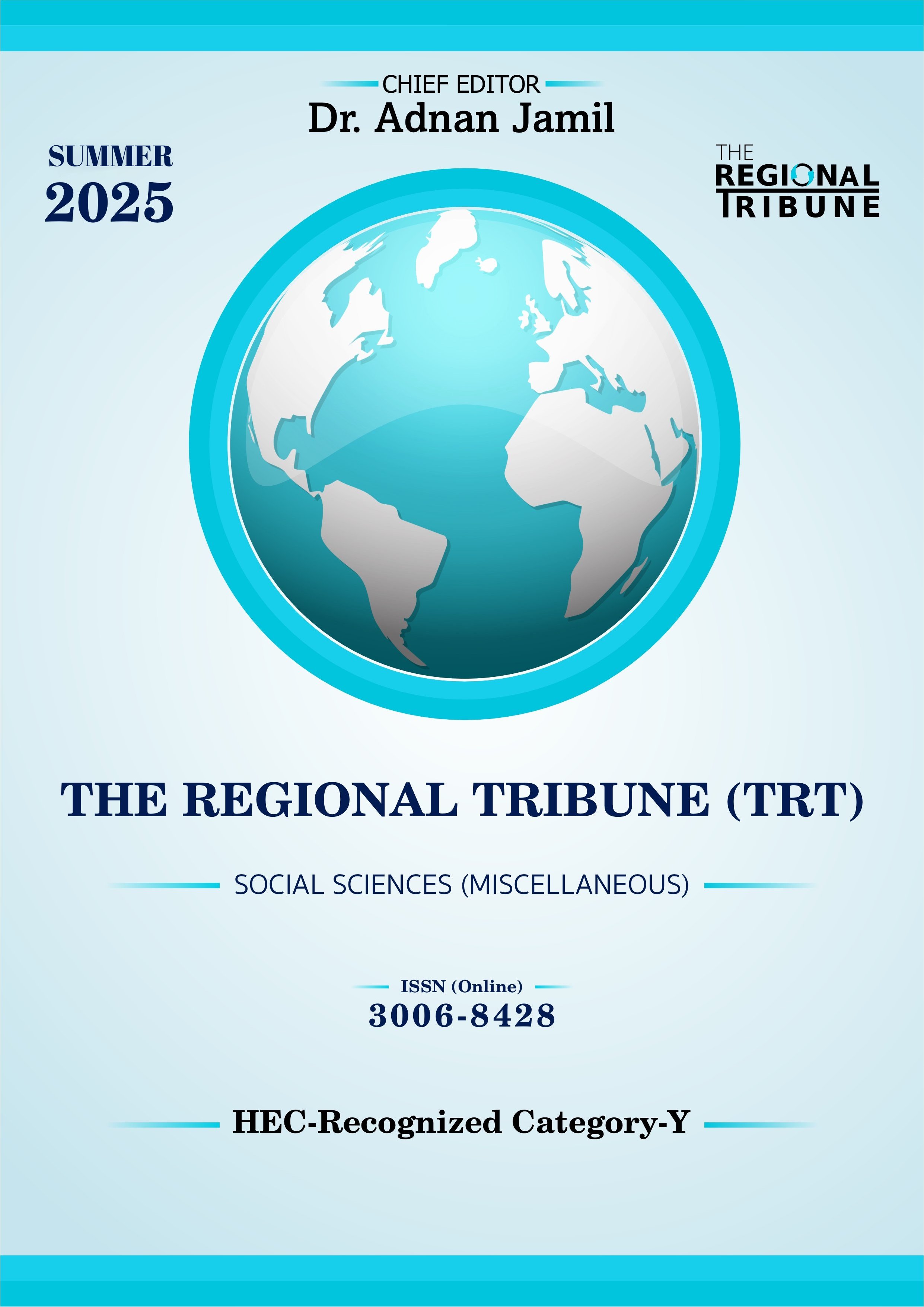Generational Differences in Adjustment Problems Among Early, Middle-Aged, and Late Adults
DOI:
https://doi.org/10.55737/trt/SR25.127Keywords:
Adult, Cross sectional study, Maladjusted, One-way ANOVA, PrevalenceAbstract
To investigate the generational differences in adjustment problems among early, middle-aged, and late Adults. It was a cross-sectional research design. The 300 adult participants' data were gathered from Gujrat and Jhelum. The sample selection was executed through convenience sampling, i.e., a non-probability sampling technique. In the demographic sheet, the age of participants was requested, whereas psychological adjustment was examined by the Scale of Adjustment for Adults by Naz, Bano & Leghari. In all three groups of adults, i.e., early, middle-aged, and late adults, the number of participants was the same. Most of the adults encounter fewer adjustment issues, n=195(65%) of adjustment problems. The Scale of Adjustment for Adults gives the cut-off score of 71 or more. Anyone who scored above 71 was considered maladjusted or not adjusted. About 21% (n=63) were maladjusted. The comparison of three adult groups was done by One-way Analysis of Variance. The result specified a difference in the psychological adjustment issues confronted by different adult groups. The Means and SD of the three groups indicated that early adulthood (64.85±10.35) has more adjustment issues than late (62.07±10.07) and middle adulthood (60.59±9.35). The study findings indicated that adults had a low level of adjustment problems, whereas the prevalence of adjustment problems was 21%. Furthermore, the three groups of adulthood experience different psychological adjustment issues.
References
American Psychiatric Association. (2013). Diagnostic and statistical manual of mental disorders (5th ed.). Arlington, VA: American Psychiatric Publishing.
Beck, A. (1964). Thinking and Depression. Archives of General Psychiatry, 10(6), 561–571. https://doi.org/10.1001/archpsyc.1964.01720240015003
Carstensen, L. L. (2006). The Influence of a Sense of Time on Human Development. Science, 312(5782), 1913–1915. https://doi.org/10.1126/science.1127488
CASEY, P., & BAILEY, S. (2011). Adjustment disorders: the state of the art. World Psychiatry, 10(1), 11–18. https://doi.org/10.1002/j.2051-5545.2011.tb00003.x
Devi, A. N., Alias, B. K., & Thomas, M. M. (2016). A study to determine the prevalence of adjustment problems among 1st year B. Sc (N) students in Narayana Nursing institution at Nellore district. IJAR, 2(7), 823-828p.
Dewey, J. (1944). Democracy and Education: An Introduction to the Philosophy of Education. Text-Book Series in Education, Free Press.
Dresden, D. (2017). Conduct disorder: What you need to know. https://www.medicalnewstoday.com/articles/320386.php
Drewelies, J., Huxhold, O., & Gerstorf, D. (2019). The role of historical change for adult development and aging: Towards a theoretical framework about the how and the why. Psychology and aging, 34(8), 1021. https://doi.org/10.1037/pag0000423
Esmael, A., Ebrahim, J., & Misganew, E. (2018). Adjustment Problem among First Year University Students in Ethiopia: Across-Sectional Survey. Journal of Psychiatry, 21(5). https://doi.org/10.4172/2378-5756.1000455
Holmes, S. C., Johnson, N. L., & Johnson, D. M. (2022). Understanding the relationship between interpersonal trauma and disordered eating: An extension of the model of psychological adaptation. Psychological Trauma: Theory, Research, Practice, and Policy, 14(7), 1175. https://psycnet.apa.org/doi/10.1037/tra0000533
Jennings, W. G., Rocque, M., Fox, B. H., Piquero, A. R., & Farrington, D. P. (2016). Can they recover? An assessment of adult adjustment problems among males in the abstainer, recovery, life-course persistent, and adolescence-limited pathways followed up to age 56 in the Cambridge Study in Delinquent Development. Development and psychopathology, 28(2), 537-549. https://doi.org/10.1017/S0954579415000486
Lachman, M. E. (2015). Mind the Gap in the Middle: A Call to Study Midlife. Research in Human Development, 12(3-4), 327–334. https://doi.org/10.1080/15427609.2015.1068048
Lung, F.-W., Lee, F.-Y., & Shu, B.-C. (2006). The Premorbid Personality in Military Students With Adjustment Disorder. Military Psychology, 18(1), 77–88. https://doi.org/10.1207/s15327876mp1801_5
Maideen, S. F. K., Sidik, S. M., Rampal, L., & Mukhtar, F. (2015). Prevalence, associated factors and predictors of anxiety: a community survey in Selangor, Malaysia. BMC Psychiatry, 15(1), 64. https://doi.org/10.1186/s12888-015-0648-x
Mayo Clinic. (2019). Adjustment disorders - symptoms and causes. Mayo Clinic. https://www.mayoclinic.org/diseases-conditions/adjustment-disorders/symptoms-causes/syc-20355224
Naz, I., Bano, Z., & Anjum, R. (2022). Construct and criterion validity of adjustment scale for adults using the correlation and Receiver-Operating Characteristics Analysis. Rawal Medical Journal, 47(1), 89-89. https://www.rmj.org.pk/fulltext/27-1582280908.pdf
Naz, I., Bano, Z., & Leghari, N. U. (2018). Construction of scales on depression, anxiety and conduct disturbance of adjustment for adults: developing a reliable measure. Isra Med J, 10(5), 310-314.
Roberts, B. W., Walton, K. E., & Viechtbauer, W. (2006). Patterns of mean-level change in personality traits across the life course: A meta-analysis of longitudinal studies. Psychological Bulletin, 132(1), 1–25. https://doi.org/10.1037/0033-2909.132.1.1
Roundy, L. (2019). Physical, Psychological and Emotional Changes in Adults Video with Lesson Transcript | Study.com. Study.com. https://study.com/academy/lesson/physical-psychological-and-emotional-changes-in-adults.html
Santrock, J. W. (2019). Life-span development (17th ed.). McGraw-Hill.
Sharma, S. (2016). Adjustment: process, achievement, characteristics, measurement and dimensions. International Journal of Academic Research, 3(1), 42-45.
Smith, K. (2019). Conduct disorder: Definition, symptoms, and treatment options. https://www.psycom.net/conduct-disorder/
Srivastava, P. S., & Singha, P. (2017). Adjustment problems of high and low academic achievers. International Journal of Advanced Education and Research, 2(4), 175-181.
Steel, Z., Marnane, C., Iranpour, C., Chey, T., Jackson, J. W., Patel, V., & Silove, D. (2014). The global prevalence of common mental disorders: a systematic review and meta-analysis 1980–2013. International Journal of Epidemiology, 43(2), 476–493. https://doi.org/10.1093/ije/dyu038
Trading Economics. (2019). Pakistan - Population. https://tradingeconomics.com/pakistan/population-ages-15-64-percent-of-total-wb-data.html
World Health Organization. (2013). Definition of key terms. https://www.who.int/hiv/pub/guidelines/arv2013/intro/keyterms/en/
Yaseen, Y. A. (2017). Adjustment disorder: Prevalence, sociodemographic risk factors, and its subtypes in outpatient psychiatric clinic. Asian Journal of Psychiatry, 28, 82–85. https://doi.org/10.1016/j.ajp.2017.03.012
Zelviene, P., & Kazlauskas, E. (2018). Adjustment disorder: current perspectives. Neuropsychiatric Disease and Treatment, Volume 14(14), 375–381. https://doi.org/10.2147/ndt.s121072
Downloads
Published
Issue
Section
License
Copyright (c) 2025 Dr. Iram Naz, Sameera Shafiq, Sadaf Wajid

This work is licensed under a Creative Commons Attribution-NonCommercial 4.0 International License.



